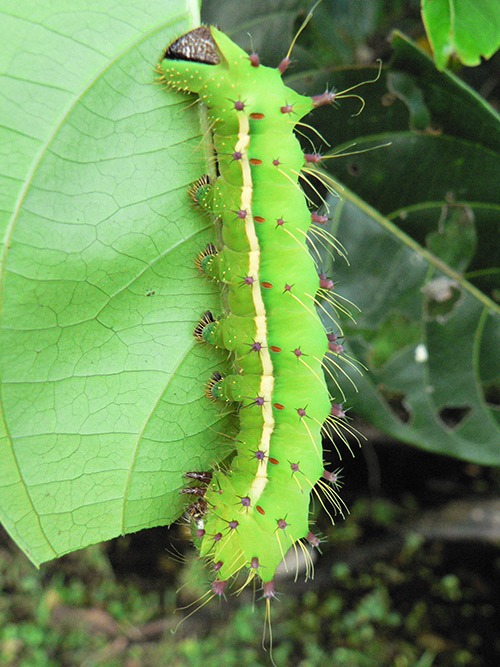The Bug Lady’s Tips on Keeping Live Insects
Insects make fantastic pets! They don’t bark, you don’t have to walk them and they won’t chew your sneakers. Keeping live insects is a great way to discover what they eat, how they move and catch their food, the ways they protect themselves from enemies and how they grow and have young. Follow my important tips below for keeping insects. Remember, you can email me any time if you have any questions (michelle@bugsed.com).
The most important rule for keeping insects is you have to know what they eat and what they need to survive. There is nothing sadder then having an insect die in your bug catcher because you didn’t know how to care for it properly. Some caterpillars will only eat a single kind of plant and will starve to death if you try to feed them anything else. Here are some tips on figuring out what your insect eats and how to care for them.
The most important rule for keeping insects is you have to know what they eat and what they need to survive. There is nothing sadder then having an insect die in your bug catcher.

© Mount Glorious Biological Centre
Predator or Herbivore?
It is very important to figure out if your insect is a Predator (eats other insects) or a Herbivore (eats plants). One way to do this is to borrow some insect books from your library (or try my book Miniature Lives – identifying insects in your home & garden) and flick through the pictures until you find something that looks like your insect.

Predator

Herbivore
Keeping Predators
Preying mantids, assassin bugs and lacewings make great pets, but can be a bit harder to keep as you need to make sure they have a constant supply of live insects to eat. This can be a bit difficult in the winter when fewer insects are around. Predators usually prefer fresh, live food like flies, crickets, caterpillars and beetle larvae. You can buy small containers of crickets and mealworms from pet shops and aquariums, which works really well. You can also catch your own flies by making a simple trap (see Make Your Own Fly Trap Fact Sheet).
You need to make sure that your food isn’t too big for your predator. Putting a massive grasshopper in with a tiny mantis is a bad idea. Not only will your mantis get scared and stressed, but also the grasshopper could kick and injure it. Small crickets or flies would be a better choice. You also need to make sure the insects you feed your predator are not poisonous. Stay away from brightly coloured moths and caterpillars and smelly stink bugs as these can make your predator sick or poison it. The best idea is to pop an insect into your predator’s container and if it hasn’t eaten it after a day or two, take it out and try something else. Try keeping a diary of what you feed your predator and how long it takes to eat it, so you can figure out its favourite foods.
Important note!!! Many pet shops will sell things like live scorpions, spiders and centipedes. While these can make fantastic pets, a great deal of responsibility comes with owning these minibeasts, as they are very dangerous. You need to make sure that you have your parent’s permission, that they are housed in a secure enclosure and you closely follow the instructions on caring for them.
Keeping Herbivores
Silkworms, butterfly larvae, stick insects, grasshoppers and giant burrowing cockroaches make fantastic pets. They are usually harmless, fast growing and easy to care for. The most important step is finding out what kind of plant they eat and then making sure you supply them with plenty of fresh leaves to munch on. If you find your insect munching on a plant, collect some of the leaves to feed it. Below is a list of some good herbivores to keep as pets and their favourite foods. Make sure the plant you cut has not been sprayed with any chemicals that could make your insects sick. Put the plant in a vase or bottle of water so that it doesn’t dry out. Make sure you plug up the neck with some tissues so your insects don’t crawl in and drown. Herbivores can eat lots of food in a very short amount of time, so make sure you check them everyday to make sure they have enough to eat. If your insects look like they are just sitting there and not eating, don’t worry. A lot of herbivores are nocturnal which means they do most of their feeding at night, when there are fewer predators like birds around.
Grasshoppers – try palm fronds, hibiscus and lettuce leaves.
Stick Insects – most species will eat gum leaves (for more info see rearing stick insects)
Silk Worms – Mulberry leaves
Wanderer Butterfly larvae – Milkweed (be careful – the sap is poisonous)
Orchard Swallowtail larvae – the leaves of lemon or orange trees
Rhinoceros Beetles – try soft fruit like banana, grapes and pears and stems of Poinciana trees.
General tips on keeping insects
- Make sure your insect (and its babies) can’t get out. Insects as pets are great – but insects running around loose in the house are not! Use an aquarium, plastic terrarium or Make Your Own Bug Box.
- Clean out your insect’s cage at least 2-3 times a week. Droppings can make the cage smelly and cause your insects to get sick.
- Keep your Bug Box out of the direct sunlight. Extreme heat can often kill insects, so keep your cage in a shaded area instead.
- Put some extra leaves, sticks, bark or rocks in your cage for your insect to use as shelter.
- Most insects shed their skin around 5 times during their life so they can grow larger (much like a snake). Make sure you don’t touch or disturb your insect when it sheds or moults its skin, as it will be very delicate during this time.
- Don’t over crowd your cage. Your insects need room to grow, move about and shed their skins properly, so start up a second box if things are getting a bit squashy.
- Keep your Bug Box in a safe place away from cats, dogs, little brothers and sisters and anything else that may tip it over.
- Make sure you don’t use things such as fly sprays and insect repellents around your insect’s cage as you can make them sick.
- Keep a diary – how often does your insect shed its skin, what’s its favourite food, how big does it grow, how many eggs can it lay? You’ll be surprised at how much you can learn!

